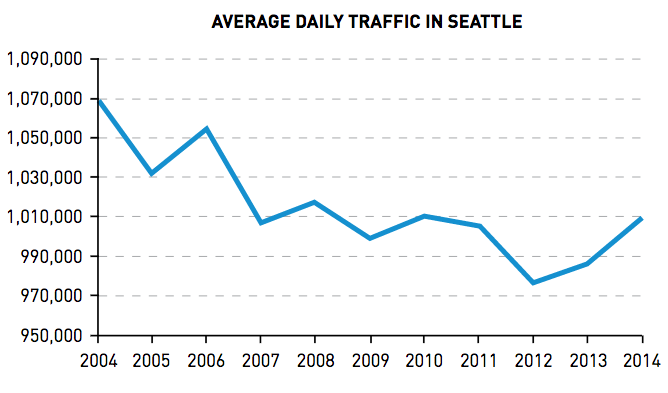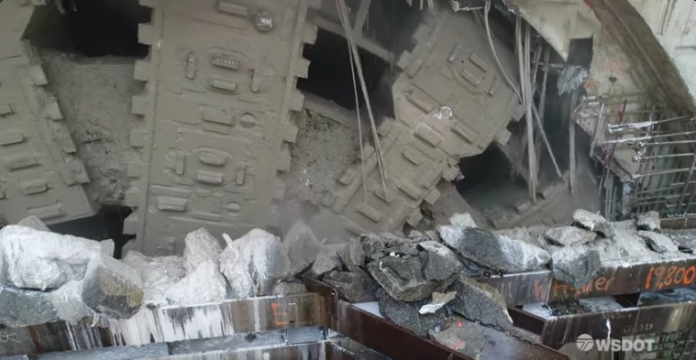The tunnel boring machine known as Bertha broke though the tunnel wall in Uptown at 11.40am on Tuesday (April 4th), completing its tunneling work and allowing former Governor Christine Gregoire to smash a bottle of champagne on its side in celebration. Now workers will dismantle the massive machine in the disassembly pit to hoist it out and scrap it for parts. Fitting on such occasion that scavengers would arrive in the form of Republicans threatening to loot Seattle to pay for the project’s cost overruns in the eleventh hour.
Last week, a gang of 10 Republican representatives dropped House Bill 2193 that would saddle any costs above $2.4 billion on the Alaskan Way Viaduct replacement project on Seattle taxpayers and would skim local revenue to force Seattle to pay. So much for Republicans believing in local control.
The original bill authorizing the project set a $2.4 billion cap on the state’s contribution to the project with another $400 million coming from future tolling revenue–but now lowered to $200 million. Other sources like federal highway funding and the Port of Seattle put up additional revenue to back the plan. With extensive delays, change orders, and a full-scale extraction and replacement effort of the tunnel boring machine’s busted cutterhead–the result of either soil conditions or a “pipe”–the project cost is now widely expected to balloon to well over $4 billion after lawsuits with the contractors are settled. Ironically, the mega-single-bore tunnel project was estimated to be $800 million cheaper than using twin-bored tunnels. The Republican bill, however, is a cynical ploy to score easy points with their rural and exurban constituents for bullying the big city and kicking it while its flank is exposed.
The language in the proposed Republican bill oddly neglects to mention tolling revenue and other known sources from the equation though:
The legislature finds that the Alaskan Way viaduct replacement project has experienced significant delays and unanticipated costs. The state has committed substantial financial resources to the project. The legislature further finds that, per RCW 14 47.01.402(6)(b), it was made clear from the outset that the state’s contribution was not to exceed two billion four hundred million dollars. Therefore, it is the intent of the legislature to ensure that the state will not bear additional costs related to the project by providing taxing authority to the city of Seattle to generate sufficient local revenue to pay for cost overruns in the event that the state or the city is found liable for these overruns.
But that’s just for starters. The bill goes much further adding provisions that would strip revenues from Seattle by skimming from local taxes such as alcohol, marijuana, and gas taxes unless the city adopts a sales tax or property tax specifically dedicated to funding the boondoggle.
A Poorly Hatched Plan
From the outset of the project, the popular opinion of replacing the Viaduct has been met with skepticism. In 2007, Seattle voters were presented with an advisory vote on competing Viaduct replacement options: elevated and tunneled. More than 100,000 voters turned out to register their widespread rejection of both proposals with 70% against the tunnel and 55% against an elevated version. This was in spite of civic leaders like Mayor Greg Nickels pushing the tunnel and years of public campaigning for replacement. But that didn’t stop backers of the tunnel–Governor Gregoire, the Downtown Seattle Association, the Port of Seattle, and waterfront interests–from turning the levers in favor. Only after another four years of campaigning did this Seattle brain trust materialize a low-turnout win in 2011 on a non-binding advisory vote for building the tunnel.
Billed as a way to reconnect Downtown Seattle to its waterfront, what wasn’t made clear at the time was that the new tunnel would not remove the need for a wide surface-level highway. Since then, the auto-focused surface highway plan has come into focus and it’s unlikely to create an especially pleasant experience for pedestrians or bicyclists. With ferry queuing lanes on the new Alaskan Way, the replaced road will balloon out to nine lanes wide.

The other elephant in the room–elephant also being the symbol of the Republican Party–is that while exurban Republicans bill the Viaduct replacement as a local Seattle project, in reality it will be used by motorists from across the region. The project has no Downtown exits showing that it’s a project allowing travel through Seattle rather than serving typical trips within the city itself. And while the total daily traffic counts on Seattle Department of Transportation (SDOT) right-of-way has been flat for years, much of the increased freeway congestion (WSDOT right-of-way) is linked to suburban sprawl and long commutes. Residents of Seattle increasingly use transit, which has allowed transit to absorb much of the trip demand from the city’s rapidly growing population. Our population has grown by more than 100,000 people since 2004, but SDOT’s daily traffic estimate is lower today than it was in 2004. Seattle itself doesn’t need the increased capacity that the tunnel and surface highway together provide; if anyone does, it’s the suburbs.
Can We Trust Tunnel Boosters?
Now the brain trust that brought you this big car tunnel project have gone on record saying Seattle wouldn’t be subject to cost overruns. Unfortunately, they’ve been wrong before when it comes to Bertha. The impetus for replacing the viaduct was the 2001 Nisqually earthquake that damaged it and exposed its lack of earthquake resiliency. Former Governor Gregoire said the viaduct would be down by 2012. Mark her words. Well it’s now 2017 and the viaduct still isn’t scheduled to come down until 2019. Hence Gregoire’s assurances that Seattle won’t be subject to cost overruns are hard to trust.
Meanwhile one Mercer Island lawmaker tried to take lemons and make lemonade in a transparent glass in her comments to The Seattle Times:
“I appreciate the fact that we are talking about $200 million, and not the ‘$2 billion’ I hear on the airwaves regularly,” added House Transportation Committee Chairwoman Judy Clibborn, D-Mercer Island. “It is not a shock that if we have a three-year delay we have some costs, and putting it out there, for the public to know that we are being very transparent about it, is great.”
Another vocal car tunnel supporter in former Seattle City Councilmember Tom Rasmussen said the contract was well-written and should protect taxpayers, according to Crosscut: “We asked our attorneys that and they assured that this is strong enough.” Former Mayor Mike McGinn wasn’t so sure saying Rasmussen didn’t even think there’d be overruns to begin with. Moreover, McGinn reminded us this week that his successor, Mayor Murray, included a provision specifying Seattle would be responsible for all cost overruns in his bill authorizing the megaproject–albeit a potentially unenforceable provision:
To make the deal work, all parties agreed that the state would not have to pay more than $2.4 billion. To meet the $3.1 billion cost, the Port of Seattle voted to pay $300 million, and the remaining $400 million was plugged with a proposed toll. But even that wasn’t good enough to overcome skepticism from the Legislature. So, then-Senate Transportation Chair Ed Murray included a provision that Seattle would pay all cost overruns. It was the only way to get the Legislature to approve the tunnel.
McGinn supported tearing down the viaduct and not replacing it at all, instead relying on surface streets and transit upgrades to carry the load. That’s the idea The Urbanist would have supported if this publication had existed when the decisions were being made a decade ago. McGinn commented this week that if we had embarked on light rail to West Seattle and Ballard following the Nisqually earthquake rather than a giant car tunnel, we would likely already have completed those projects by now.
The state’s governor at the time denied that approach. “When you look at the options, the one that was most sound environmentally is the one we chose,” Gregoire said. “You don’t just take down the viaduct and do nothing.”
Environmentally sound is an odd descriptor for a giant project to serve cars — the primary source of greenhouse gas emissions in our state. The project, even with modest tolls, will induce demand and keep more cars on the road rather than encouraging alternatives. Plus, not only did the dig produce thousands of tons of sludge, but constructing the world’s largest tunnel boring machine and shipping it in from Japan obviously has carbon costs, too. Seattle wanted a real environmental solution in the form of better transit, walking and biking options, not thinly-veiled greenwashing.
It’s rich to be told how Seattle should pay for cost overruns on a project it didn’t even want in the first place. Call your representatives to tell them to shut down the ridiculous Republican House Bill 2193.
Doug Trumm is publisher of The Urbanist. An Urbanist writer since 2015, he dreams of pedestrian streets, bus lanes, and a mass-timber building spree to end our housing crisis. He graduated from the Evans School of Public Policy and Governance at the University of Washington in 2019. He lives in Seattle's Fremont neighborhood and loves to explore the city by foot and by bike.


